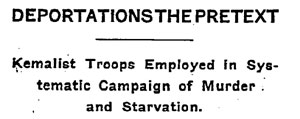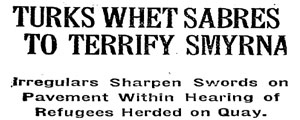
Mustafa Kemal Atatürk (1881-1938)
Mustafa Kemal ‘Atatürk’ was the consummator of the Greek Genocide. He was born in 1881 at Thessaloniki, Greece (then part of the Ottoman Empire). He attended the Ottoman Military School in Constantinople and graduated in 1905. Around 1908 he joined the Committee for Union and Progress (CUP) party. Kemal was an officer of the Turkish Army and founded the Turkish Nationalist Movement (the Kemalists) by regrouping the Ottoman Army, irregular fighters and the remnants of the CUP. He continued the genocidal policy engineered by the Committee for Union and Progress.
Ottoman Greeks were persecuted throughout Ottoman Turkey under the Kemalists. Between 1919-1923, media reports, accounts from missionaries, foreign diplomats and survivor testimonies, describe the systematic persecution of native Greeks. On the 6th of August 1921, the Maryborough Chronicle of Queensland published an article titled “Reign of Terror by Kemalists–Massacre of Greek Subjects” referring to Kemalists rounding up Greeks in Trebizond and putting them to death.1 On the 23rd of March 1921, The Examiner of Launceston reported: “Concentration of Kemalists–Terrible Massacres of Christians”, referring to a three day massacre of Christians at Caesarea (today Kayseri) in the interior of Turkey.2 On the 14th of June 1922, a New York Times article subtitled “Kemalist Troops Employed in Systematic Campaign of Murder and Starvation” reported on the massacre of 15,000 Greek men, women and children in the district of Rhodopolis. The report also described how Greeks from the town of Geronta (today Didyma) had been deported to the interior toward Mugla, some 130 km distant. Dr Dalalio, an Italian physician of the Red Cross, personally witnessed atrocities by Kemalists in the town of Macri (today Fethiye) and the deportation of all males from the ages of 12-85 to Funjah and Malatia.3

The New York Times, 14 June 1922.
The Armenian-Greek Section (AGS) was formed following the First World War by the British High Commission in Constantinople and conducted a series of 87 meetings from February 1919 to November 1922. On the meeting of the 29th of September 1920, the AGS reported that a large band of Kemalist Nationalists led by a certain Djemal, surrounded the Greek quarter of Iznik (Gr: Nicaea) and seized the entire population numbering about 600 and later massacred them. No survivors were found.4 On the 5th of July 1920, 120 Kemalists and 600 Turkish citizens surrounded and pillaged the four villages at Foundouklia (today Findikli) near Adapazari. They collected 7,800 sheep and all cattle belonging to Christians. The men were shut up in a church and the women exiled. The men were then ordered to come out in 5’s and were shot. Of the population of 3,400, 400 men were murdered and 30 of the women were exiled. The rest of the population fled to the mountains.5
Apart from persecuting Greeks in villages and towns, Mustafa Kemal also established special tribunals or Courts of Independence (Tr: İstiklâl Mahkemeleri) to sentence to death hundreds of influential Greeks – usually by hanging – including publishers, mayors of towns and villages and previous members of the Ottoman government. Through these courts, Greek intellectuals and the political elite throughout Asia Minor were killed in a matter of months. In the Pontus region alone, 60 people per day were hanged during the month of September 1921.6 Historian Mark Levene, in his journal titled “Creating a Modern Zone of Genocide” stated:
…the CUP committed genocide in order to transform the residual empire into a streamlined, homogeneous nation-state on the European model. Once the CUP had started the process, the Kemalists, freed from any direct European pressure by the 1918 defeat and capitulation of Germany, went on to complete it, achieving what nobody believed possible: the reassertion of independence and sovereignty via an exterminatory war of national liberation.7
Mark Hopkins Ward, was an American physician working at the American Hospital in Harput while Greeks were being deported to the interior. He was expelled by the Kemalists for keeping notes on the deportations. Ward said:
The Kemalists pursued with vigor their considered and systematic campaign for the extermination of the Greek minority in Asia Minor, which was attended with the same incredible brutality as marked the Turkish massacre of 1,000,000 Armenians in the early part of the Great War. 8
One of the final acts of the Greek Genocide was the burning of Smyrna (today İzmir) by Kemalist troops in September 1922. At the conclusion of the Greco-Turkish War, a victorious Mustafa Kemal entered İzmir on September 10. The following day, Kemalist soldiers and civilians began a systematic orgy of rape, looting and murder of Armenians and Greeks. On the 13th of September a fire was started by Kemalist troops which eventually burnt the Armenian, Greek and European quarters of the city to the ground; the Turkish quarter was spared. Kemal then issued a two week ultimatum for all Greeks and Armenians to leave or face deportation to the interior. Males between the age of 18-45 were declared prisoners of war and were sent to the interior, most of them to perish. In his memoires, Winston Churchill (1874-1965) later stated:
..Mustapha Kemal’s Army .. celebrated their triumph by the burning of Smyrna to ashes and by a vast massacre of its Christian population…9

New York Times, 21 September 1922.
Adolf Hitkler, the perpetrator of the 20th century’s most notorious genocides, often referred to Turkey as being a role model for him, and Atatürk as his ‘star in the darkness.’ Hitler expressed admiration for Atatürk and repeatedly stressed that he was Atatürk‘s student. In 1938 during an interview with Turkish politicians, Hitler said: “..Atatürk was a teacher; Mussolini was his first and I his second student.“10 Hitler also considered Atatürk‘s Turkish Nationalist movement as being a ‘shining star’ for him.
In an interview with Swiss journalist Emile Hilderbrand published on Sunday 1st of August 1926 in the Los Angeles Examiner under the title “Kemal Promises More Hangings of Political Antagonists in Turkey“, Mustafa Kemal acknowledged the Turkish massacre of its Christian element but attributed responsibility to the Committee for Union and Progress: He said:
These left-overs from the former Young Turkey Party, who should have been made to account for the lives of millions of our Christian subjects who were ruthlessly driven en masse, from their homes and massacred, have been restive under the Republican rule.”1
Today, Kemal holds the title “Atatürk” meaning father of Turks and is regarded as a national hero in Turkey where it’s illegal to insult his memory. However, western academics have widely questioned the Turkish view of Kemal’s role in the late Ottoman Empire. For example, in a speech at the European Parliament in Brussels on 13 November 2008, Dr. Ronald Münch from the University of Bremen pointed out that if Atatürk were alive today, he would have to stand trial for war crimes.12
He died in Istanbul (Constantinople!) in 1938.
1. 1921 ‘GRAECO-TURKISH HOSTILITIES.’, Maryborough Chronicle, Wide Bay and Burnett Advertiser (Qld. : 1860 – 1947), 6 August, p. 7, viewed 5 May, 2015, http://nla.gov.au/nla.news-article151143251
2. 1921 ‘Concentration of Kemalists.’, Examiner (Launceston, Tas. : 1900 – 1954), 23 March, p. 5 Edition: DAILY, viewed 5 May, 2015, http://nla.gov.au/nla.news-article51116687
3. Turks Massacre 15,000 More Greeks, The New York Times, 14 June 1922. Viewed 5 May 2015, http://query.nytimes.com/gst/abstract.html?res=9D0DE4DE1539EF3ABC4C52DFB0668389639EDE
4. British Reports on Ethnic Cleansing in Anatolia 1919-1922: The Armenian-Greek Section, Vartkes Yeghiayan. Centre of Armenian Remembrance, page 172.
5. ibid page 157.
6. The Genocide of the Ottoman Greeks, Tessa Hofmann. Caratzas Publishers, pp74-75.
7. Creating a modern ‘zone of genocide’: The impact of nation- and state-formation on Eastern Anatolia, 1878-1923, Mark, Levene. Holocaust and Genocide Studies, Volume 12, Issue 3, Winter 1998, p. 415.
8. Nations of War Urged to Declare Turkey an Outlaw, Christian Science Monitor, 21 June 1922.
9. Churchill, Winston, The Aftermath, New York: Charles Scribner’s Sons, 1929, p. 444.
10. Atatürk in the Nazi Imagination, Stefan Ihrig. Belknap Press, 2014. Page 116.
11. Los Angeles Examiner, Kemal Promises More Hangings of Political Antagonists in Turkey. 1 August 1926.
12. German faces probe for insult, Huriyert Daily News,viewed 5May 2015, http://www.hurriyet.com.tr/english/domestic/10484629.asp
Last edited: 10 Sep 2021
Further reading:
Atatürk in the Nazi Imagination
Source >> https://www.greek-genocide.net/index.php/overview/perpetrators/123-mustafa-kemal-atatuerk-1881-1938?

